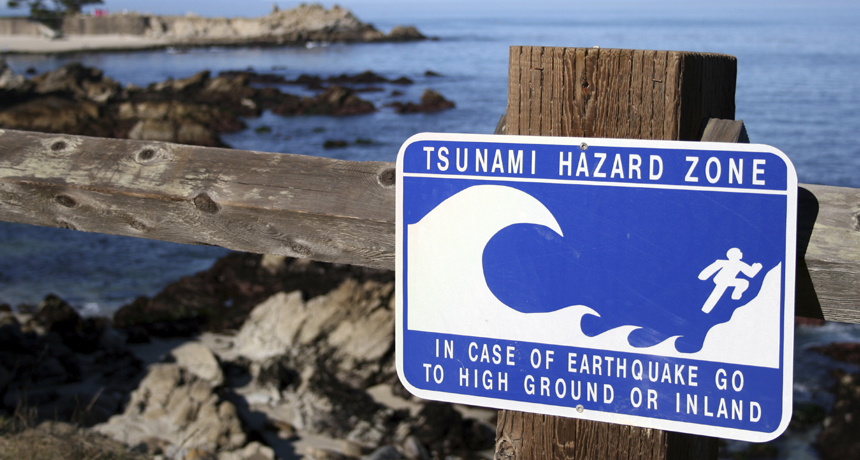Explainer: Telling a tsunami from a seiche
Like the waves caused by jostling in a bathtub — these move water, only enormously more water and with more devastating power

A sign in Monterey, Calif., warning that this coastal area is vulnerable to tsunamis.
akiyo/iStockphoto
Splash in the bathtub and waves slosh. Toss a rock into a pond and ripples move outward in expanding rings. In each case, the water moves in waves. Those waves carry energy. And the more energy that gets added to a watery environment, the more powerful the waves may become.
Now imagine an undersea earthquake or landslide and the tremendous amount of energy it can transfer. This movement of Earth’s crust can shift huge volumes of water, unleashing a parade of great and powerful waves. This water races away at speeds up to 800 kilometers (500 miles) per hour, or as fast as a jet plane.
Eventually those waves reach shallow water. Here, they slow down and swell, sometimes as high as a 10- or 20-story building. When the waves eventually crash onto land, they can swamp hundreds of kilometers of shoreline. They may snap trees like twigs, collapse office buildings and sweep away cars. Among nature’s most powerful forces of destruction, these waves are called tsunamis (tzu NAAM eez). The Japanese term means “harbor wave.”
Tsunamis strike coastal regions about 10 times every year. And in coastal regions, tsunamis are often the main cause of deaths associated with earthquakes.
There’s no stopping a tsunami. There are, however, ways to limit its impacts.
Getting people out of the way is the most important. So scientists like oceanographer Dailin Wang, who watches for tsunamis at the Pacific Tsunami Warning Center in Hawaii, are developing fast and accurate tsunami forecasts. These researchers keep an eye on the Earth using a worldwide network of buoys, seismometers and satellites. When necessary, these experts warn shoreline populations that potentially devastating waves are on the way.
And one day, it might be possible to use cloaking technologies to lessen a tsunami’s destruction. Technologies to do this are already under development, although no one is certain how well they will work.
The ocean isn’t the only place where large water waves can wreak havoc. In a swimming pool, large lake or any other enclosed body of water, a wave known as a seiche (SAYSH or SESH) may form.
Earth scientist David Mencin says a seiche is more like the slosh in a bathtub than a tsunami. A seiche can develop when the wind blows across a lake for a long time. That wind piles up water at one shore. When the wind stops, the water flows back (and then forth) as a wave. Sometimes seismic waves from an earthquake can even trigger a seiche — even half a world away!
And although lesser known and generally smaller than tsunamis, seiches still can be deadly.
Power Words
buoy A floating device anchored to the bottom of a body of water. A buoy may mark channels, warn of dangers or carry instruments to measure the environment.
earthquake A sudden and sometimes violent shaking of the ground, sometimes causing great destruction, as a result of movements within Earth’s crust or of volcanic action.
seiche A temporary disturbance or oscillation in the water level of a lake or other enclosed body of water, especially one caused by changes in atmospheric pressure.
seismic wave A wave in the ground produced by an earthquake or other means.
seismometer An instrument that detects and measures tremors (known as seismic waves) as they pass through Earth. The graphical output of the waves it detects is known as a seismograph.
tsunami One or many long, high sea waves caused by an earthquake, submarine landslide or other disturbance.







